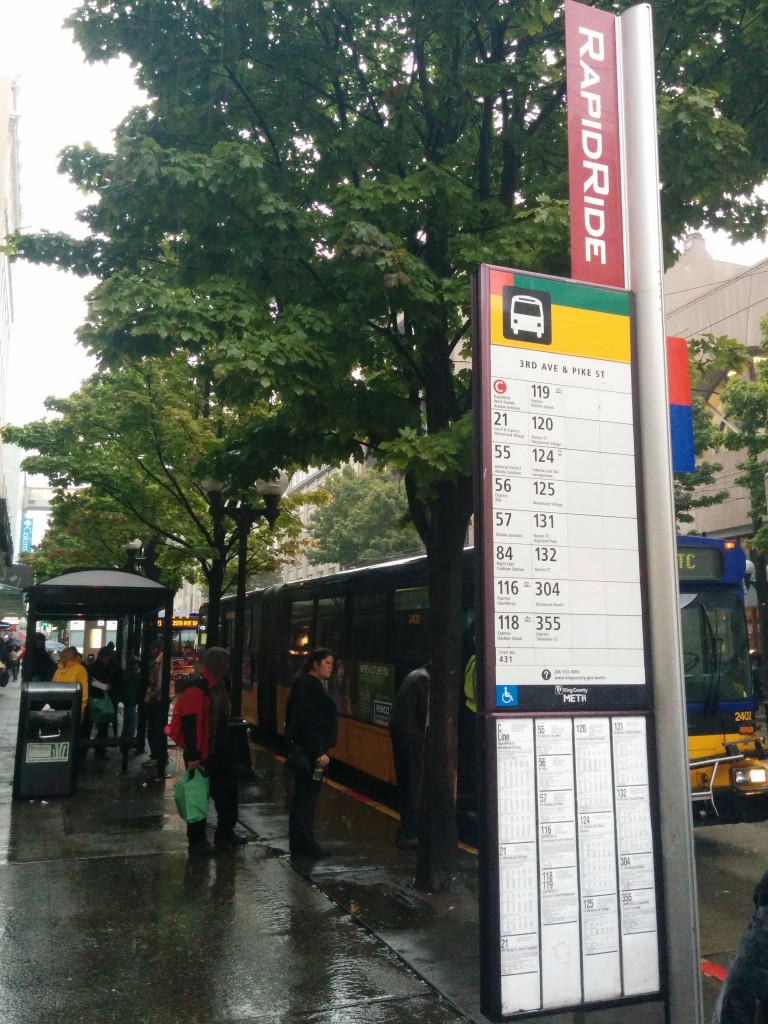Kristina’s throwing in her copy of Cloud Atlas. Alex is going to donate his copy of Tipping Point. Another teammate is adding (meditatively?) Siddhartha to the stack. But these are just the first few in what they hope will become a very, very large pool of titles, because what Kristina Krause and her justifiably fired-up team leading this ioby campaign really want is all the books. That’s right. They’ve got big ideas about how to make Seattle’s public transportation system more inspiring, and they need all the books you’ve got lying around at home. You won’t get your own books back, but you will have the pleasure of knowing you’ve turned someone else’s mind-numbing commute into a journey of literary discovery. And they just might do the same for you.
Here’s how it’ll work. On November 21st, Kristina and her team – a group of public transit and library enthusiasts who regularly brainstorm over Facebook – will, at ten public transit hubs in Seattle, set up drop boxes for books: a free, communal library of sorts. While you wait to catch your bus to work, see if anything in the box catches your eye. If you do spy a tempting title, just enter your name into the logbook, and it’s yours for as long as you want it. Take the book home if you like, and drop it back in circulation anytime, at any of the drop points, along with whatever else you might want to contribute from your own personal library.
It’s an idea that’s already taken flight at Cape Town’s airport: the FlyBrary, which has been up and running, steadily gaining popularity, and completely sustaining itself, for 4 months now. Could book sharing be the next frontier in inspirational transit?
To be clear, Seattle’s not short on readers or on books; it’s been ranked the second most literate city in America for four years running, and Alex Epstein, one of Krause’s ioby teammates, says that many of his fellow public transit commuters already read to pass the time. But there’s something just that extra bit comforting, that extra bit exciting, about selecting your reading material from a collective pool – being a part of the community in that way. “It’s also being a part of the Seattle cultural brand,” says Epstein, who wants to see Seattle become the first city with a public transit-driven free community library.
“We need to save our transit system,” says Epstein. “A lot of people use it, but not enough. You have to wait for half an hour for your bus, and then it’s a bumpy ride. We need to make it more entertaining.” It doesn’t seem so hard to imagine that if ridership and general enthusiasm went up, the city might feel more confident about investing in and reviving the infrastructure itself.
The team is working with local artists and welders to create free-standing book boxes, which will look similar to the ubiquitous newspaper machine, only beautiful! And no two will be alike. Someone’s old file cabinet, for example, has been earmarked for repurposing as one of the initial ten book boxes.
Better yet, the book boxes will serve as community bulletin boards, too, where Seattle’s public library might advertise, say, a lecture with Cornell West, or a “lunchtime story” event. Epstein says the team wants to make more accessible the sorts of “thought leaders that people might not even know about, if they don’t visit the library.” To ensure that they reach Seattle residents of all socioeconomic backgrounds, the team has mapped out their initial 10 sites with diversity and traffic density in mind. They want to bring library services to new audiences. Free books, free advertising for libraries, and a – dare we say it – fun commute? What could be more Seattle than that, and what could be better?
And speaking of new audiences, the team wants kids on board, too. “We just want all the books,” says Epstein. “We’ve been thinking about how exciting it would be to have kids books. That’s so hard as a parent – taking kids on trains. That would be a beautiful gift to parents.”
See All Trick Out My Trip Campaigns
The ioby Trick Out My Trip opportunity is funded by Transit Center.



